Competency-Based Instruction
November 22, 2021 | Found in: Individually-paced curriculum, Competency-based, and Teacher

Co-founder/CEO
An Introduction to One of the Key Principles behind the Design of Levered Learning
Competency-based instruction is a way of teaching that focuses on ensuring that students demonstrate facility with specific skills, or competencies. In the case of Levered's curriculum, the goal is to have students demonstrate their ability to understand and apply the skills and concepts outlined in the Common Core State Standards for mathematics.
In a competency-based model, a student's learning experience is determined primarily based on their needs as an individual learner, not on the average needs of their classmates. This is not only a more effective approach, but fundamentally a more just and equitable one.
Listen to our founder, Mitch Slater, discuss competency-based instruction with Dr. Monica Burns, on the Easy EdTech Podcast.
In order to fully understand competency-based instruction, it is useful to contrast it with coverage-based instruction, which is a common strategy among teachers who are presented with an extensive list of standards. When using a coverage model, an instructor focuses on teaching every standard that is listed for a given grade level. This commonly results in moving through material relatively quickly and an approach that views success as having "checked all the boxes."
Let's look at a hypothetical situation to further clarify the differences between competency-based and coverage-based instruction.
Imagine a 4th grade class with 30 students:
- 15 of these students have a history of learning mathematics at an average pace, and test more or less at grade level.
- 10 of these students have struggled to learn math as quickly as their peers, and on average test a year or more below grade level.
- The remaining 5 students tend to learn new math concepts quickly and easily, and test above grade level.
If a coverage-based approach is taken to teaching every standard from the 5 domains in the CCSS for this grade, the teacher will need to move quickly through each of these areas. Often this will mean that the teacher is making a decision to finish teaching a topic based upon how much time remains in the school year. At the end of the year, all the standards have been taught, but the different groups of students described above have had very different learning experiences:
- The 5 students who started the school year above grade level are likely to have learned all the covered material, but are also likely to have experienced a low level of challenge, as they already had demonstrated an understanding of much of the grade level curriculum.
- The 15 students who started the year more or less at grade level are also likely to have learned the covered skills and concepts, and are more likely to have experienced an appropriate level of challenge throughout the year.
- The 10 students with a history of struggle in mathematics are likely to have fallen further behind, since the pre-existing gaps in their foundational understanding were not addressed in the rush to cover the grade level content.
Let's continue the thought experiment by rewinding to the start of the year and imagining a competency-based approach with the same 30 students. In this scenario, the teacher hopes to cover all the standards, but their primary goal is to have every student learn as much as possible in each of the 5 domains.
Instead of making decisions solely based on how many months or weeks are left in the year and a rigid pacing guide, the teacher’s decisions are guided by formative assessment data.
At the end of the year:
- The 5 students who had started the year above grade level have mastered each and every grade level standard, and completed many enrichment lessons that deepened their understanding and stretched their thinking. In some cases, these students may have had the opportunity to advance to lessons at the next higher grade level.
- The 15 students who started at grade level have again learned the critical grade level skills and concepts, and some are likely to have had the opportunity to engage in more challenging enrichment work in one or more units.
- The 10 students who started the year below grade level have had the opportunity to take the needed time to fill in the gaps in their foundational learning, increasing their confidence and fundamentally shifting their experience of learning mathematics. Some of these students will have caught up to grade level proficiency, but it’s likely that all of them will have made more than a year’s progress relative to their starting level of understanding.
It is Levered’s fundamental belief that we must consider the needs of each learner as an individual, and that the past performance of a student on summative assessments should not be used as a predictor of future performance or capacity to learn. In fact, it has been our experience that, in a competency-based learning environment, students often demonstrate levels of both growth and performance well beyond the levels they showed historically through a coverage-based approach.
Growth for all comes from the right mix of challenge & support
Read more about how we approach, build for, and support competency-based learning, download our 2019 pilot brief study by Digital Promise, and reserve time on Oscar's calendar to learn more and see a demo.
